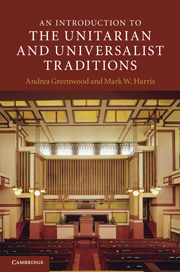Book contents
- Frontmatter
- Contents
- Acknowledgements
- A note on names
- Chapter 1 Introduction
- Chapter 2 Beginnings
- Chapter 3 Great Britain
- Chapter 4 From revelation to reason
- Chapter 5 From reason to intuition to freedom
- Chapter 6 A religion for one world
- Chapter 7 Congregational polity
- Chapter 8 Worship
- Chapter 9 Sources of faith
- Chapter 10 Science and ecology
- Chapter 11 Architecture, art, and music
- Chapter 12 Education and social justice
- Chapter 13 Current issues, new directions
- Selected bibliography
- Index
- References
Chapter 11 - Architecture, art, and music
Published online by Cambridge University Press: 05 June 2012
- Frontmatter
- Contents
- Acknowledgements
- A note on names
- Chapter 1 Introduction
- Chapter 2 Beginnings
- Chapter 3 Great Britain
- Chapter 4 From revelation to reason
- Chapter 5 From reason to intuition to freedom
- Chapter 6 A religion for one world
- Chapter 7 Congregational polity
- Chapter 8 Worship
- Chapter 9 Sources of faith
- Chapter 10 Science and ecology
- Chapter 11 Architecture, art, and music
- Chapter 12 Education and social justice
- Chapter 13 Current issues, new directions
- Selected bibliography
- Index
- References
Summary
The current trend towards “green” church buildings among Unitarian Universalists is part of a long history of innovation and adaptation that began with secret meeting spaces and hidden chapels in sixteenth-century England, and continued in a variety of forms over the centuries. Because Unitarianism is so strongly associated with “the Word,” most expositions of the faith are literary. But there is a strong visual and spatial tradition associated with Unitarianism, some of which correlates with the more elite strain for which the religion is known, and some of which provides access to a different theme within Unitarianism; one which is closely allied to the “folk” – the people who live and work on the land, and the rhythm of that life in nature, punctuated by protests against the powerful and demands for justice.
The Iowa Sisterhood, a Western group of female clergy in the late nineteenth and early twentieth centuries, was responsible for the construction of over twenty new churches in the Midwest between 1880 and 1913. These buildings had kitchens, gyms, and offices, and were intended for use seven days a week. They were practical, affordable, and communicated more than a liberal Social Gospel christology. Traditional-looking churches symbolized patriarchal power. The home, a place of power for women, became a model for these clergy. Jenkin Lloyd Jones, who championed the Iowa Sisterhood, also supported the idea of church as home as it related well to the house-church tradition of his Welsh Unitarianism. The multi-purpose church buildings in the Midwest were progressive, but they actually resurrected the original Puritan ideal: democratic meeting spaces designed with practical needs in mind, not set apart as sacred space. The goal was human comfort, or uplift through service, not inspiration. Although the theological rationale differed, the early humanists revived the Puritan distrust of religious art.
- Type
- Chapter
- Information
- An Introduction to the Unitarian and Universalist Traditions , pp. 201 - 213Publisher: Cambridge University PressPrint publication year: 2011



